The Impact of Digital Technology on Business Activities: Tesco Study
VerifiedAdded on 2020/11/12
|9
|2657
|294
Report
AI Summary
This research project analyzes the impact of digital technology on the business activities of Tesco, a retail-based organization. The study aims to determine the role of digital technology in enhancing Tesco's productivity and business operations. The report includes an introduction outlining the background, aim, objectives, and research questions. A literature review explores the concept of digital technology and its relationship with increased productivity. The methodology section details the research approach, data collection methods, research philosophy, and sampling techniques used. The research employs a qualitative approach, utilizing primary data collection methods to investigate the influence of digital technology on Tesco's efficiency. The project also addresses research limitations and provides a timescale for the analysis. The findings of this study are crucial for understanding how digital transformation can improve operational processes, customer engagement, and overall business performance within the retail sector, specifically highlighting the case of Tesco.

Research Project
Paraphrase This Document
Need a fresh take? Get an instant paraphrase of this document with our AI Paraphraser
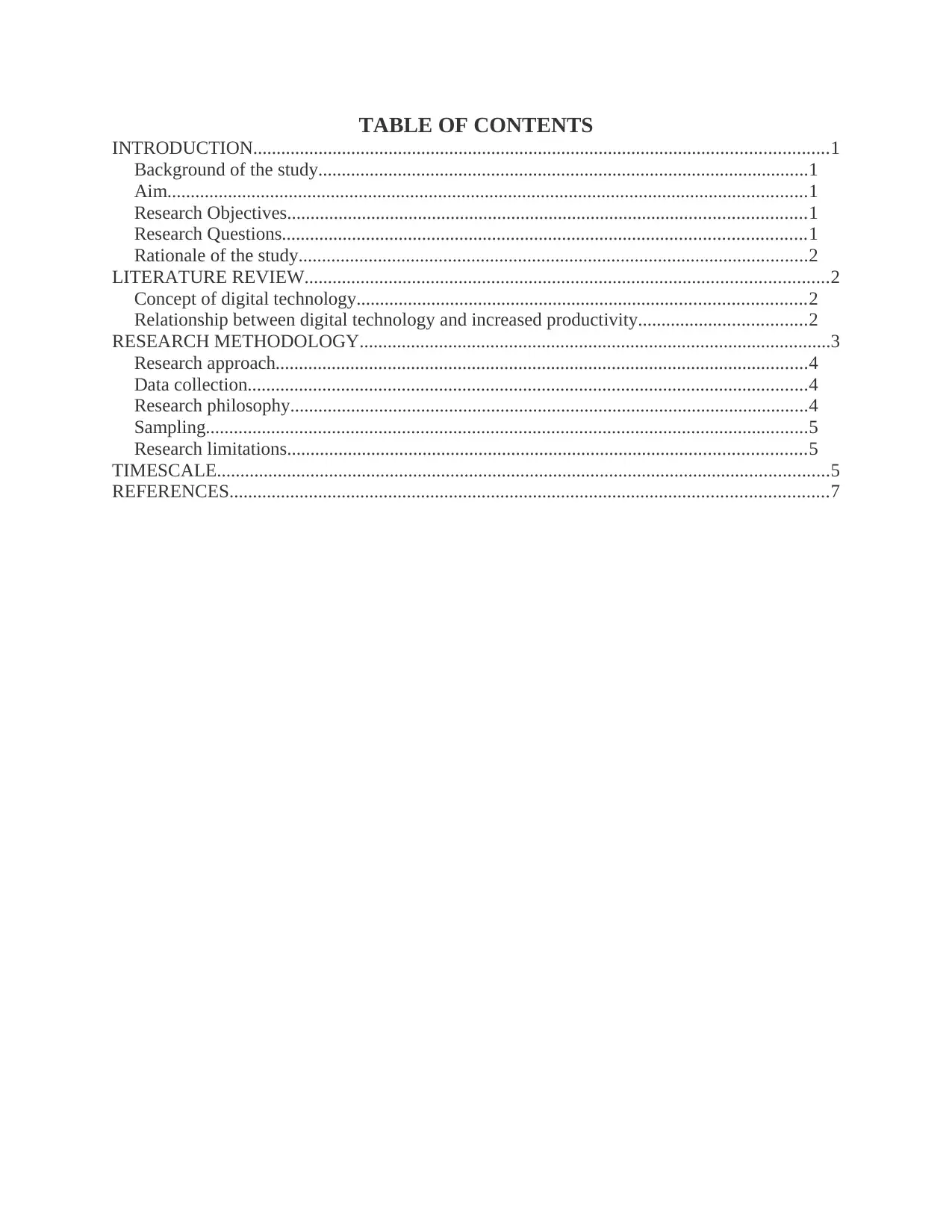
TABLE OF CONTENTS
INTRODUCTION...........................................................................................................................1
Background of the study.........................................................................................................1
Aim.........................................................................................................................................1
Research Objectives...............................................................................................................1
Research Questions................................................................................................................1
Rationale of the study.............................................................................................................2
LITERATURE REVIEW................................................................................................................2
Concept of digital technology................................................................................................2
Relationship between digital technology and increased productivity....................................2
RESEARCH METHODOLOGY.....................................................................................................3
Research approach..................................................................................................................4
Data collection........................................................................................................................4
Research philosophy...............................................................................................................4
Sampling.................................................................................................................................5
Research limitations...............................................................................................................5
TIMESCALE...................................................................................................................................5
REFERENCES................................................................................................................................7
INTRODUCTION...........................................................................................................................1
Background of the study.........................................................................................................1
Aim.........................................................................................................................................1
Research Objectives...............................................................................................................1
Research Questions................................................................................................................1
Rationale of the study.............................................................................................................2
LITERATURE REVIEW................................................................................................................2
Concept of digital technology................................................................................................2
Relationship between digital technology and increased productivity....................................2
RESEARCH METHODOLOGY.....................................................................................................3
Research approach..................................................................................................................4
Data collection........................................................................................................................4
Research philosophy...............................................................................................................4
Sampling.................................................................................................................................5
Research limitations...............................................................................................................5
TIMESCALE...................................................................................................................................5
REFERENCES................................................................................................................................7
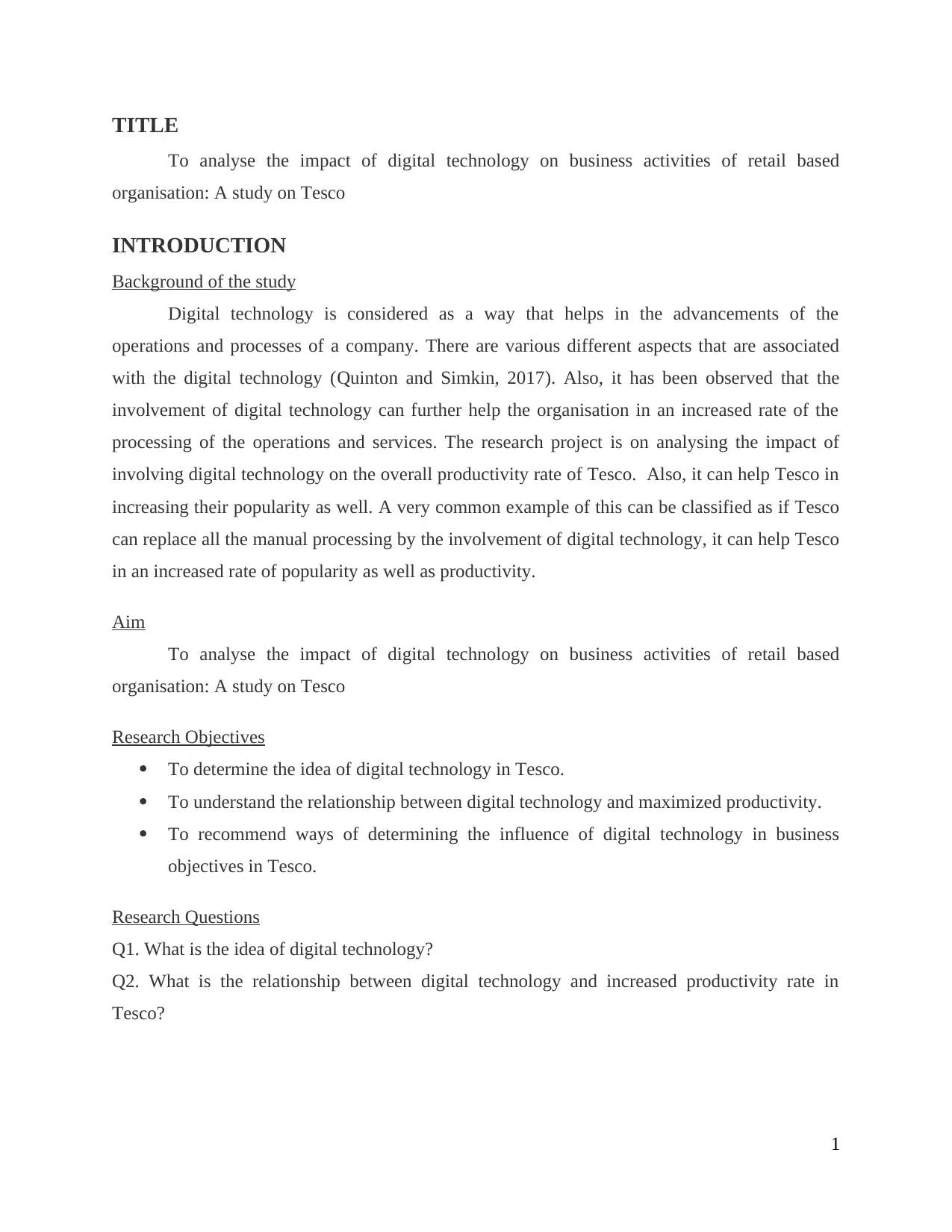
TITLE
To analyse the impact of digital technology on business activities of retail based
organisation: A study on Tesco
INTRODUCTION
Background of the study
Digital technology is considered as a way that helps in the advancements of the
operations and processes of a company. There are various different aspects that are associated
with the digital technology (Quinton and Simkin, 2017). Also, it has been observed that the
involvement of digital technology can further help the organisation in an increased rate of the
processing of the operations and services. The research project is on analysing the impact of
involving digital technology on the overall productivity rate of Tesco. Also, it can help Tesco in
increasing their popularity as well. A very common example of this can be classified as if Tesco
can replace all the manual processing by the involvement of digital technology, it can help Tesco
in an increased rate of popularity as well as productivity.
Aim
To analyse the impact of digital technology on business activities of retail based
organisation: A study on Tesco
Research Objectives
To determine the idea of digital technology in Tesco.
To understand the relationship between digital technology and maximized productivity.
To recommend ways of determining the influence of digital technology in business
objectives in Tesco.
Research Questions
Q1. What is the idea of digital technology?
Q2. What is the relationship between digital technology and increased productivity rate in
Tesco?
1
To analyse the impact of digital technology on business activities of retail based
organisation: A study on Tesco
INTRODUCTION
Background of the study
Digital technology is considered as a way that helps in the advancements of the
operations and processes of a company. There are various different aspects that are associated
with the digital technology (Quinton and Simkin, 2017). Also, it has been observed that the
involvement of digital technology can further help the organisation in an increased rate of the
processing of the operations and services. The research project is on analysing the impact of
involving digital technology on the overall productivity rate of Tesco. Also, it can help Tesco in
increasing their popularity as well. A very common example of this can be classified as if Tesco
can replace all the manual processing by the involvement of digital technology, it can help Tesco
in an increased rate of popularity as well as productivity.
Aim
To analyse the impact of digital technology on business activities of retail based
organisation: A study on Tesco
Research Objectives
To determine the idea of digital technology in Tesco.
To understand the relationship between digital technology and maximized productivity.
To recommend ways of determining the influence of digital technology in business
objectives in Tesco.
Research Questions
Q1. What is the idea of digital technology?
Q2. What is the relationship between digital technology and increased productivity rate in
Tesco?
1
⊘ This is a preview!⊘
Do you want full access?
Subscribe today to unlock all pages.

Trusted by 1+ million students worldwide
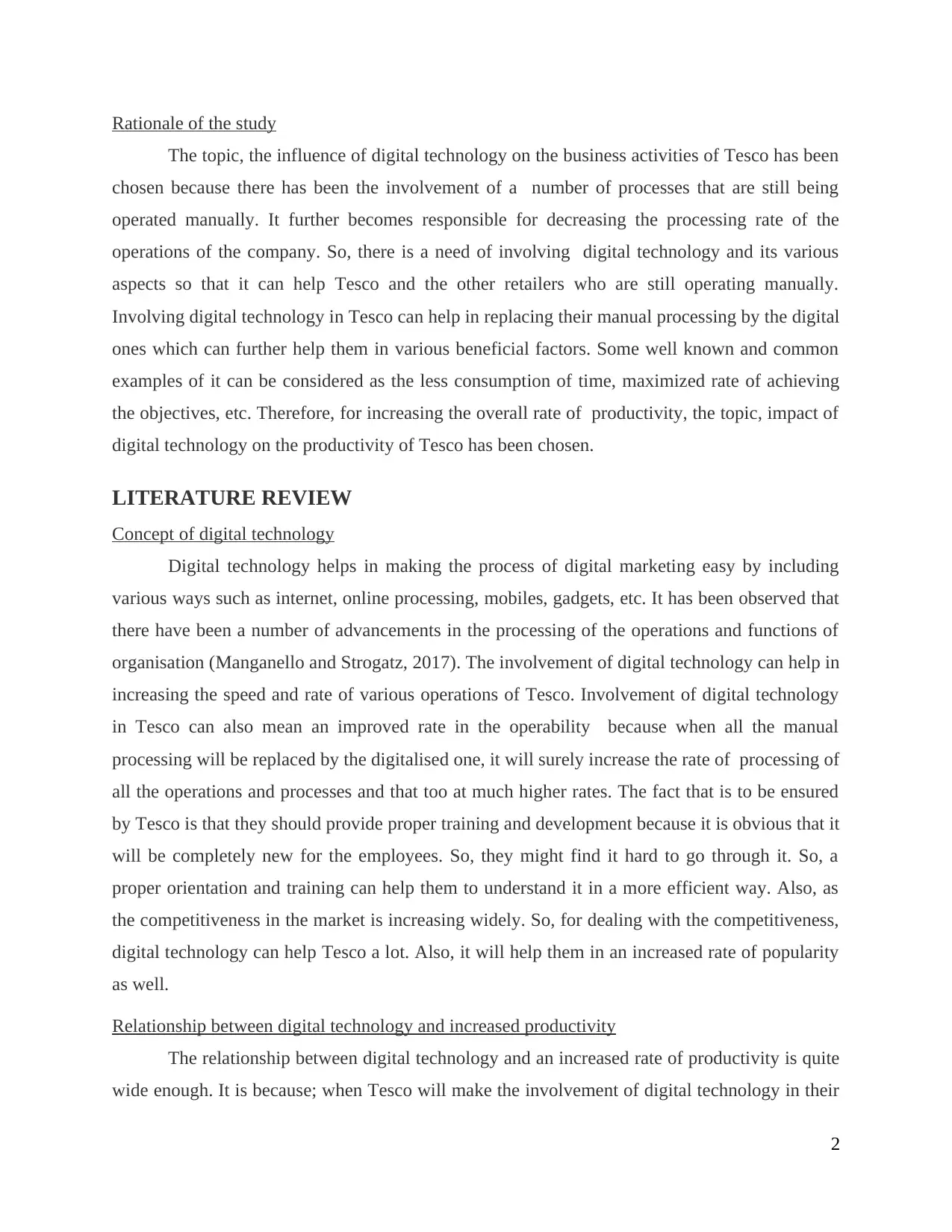
Rationale of the study
The topic, the influence of digital technology on the business activities of Tesco has been
chosen because there has been the involvement of a number of processes that are still being
operated manually. It further becomes responsible for decreasing the processing rate of the
operations of the company. So, there is a need of involving digital technology and its various
aspects so that it can help Tesco and the other retailers who are still operating manually.
Involving digital technology in Tesco can help in replacing their manual processing by the digital
ones which can further help them in various beneficial factors. Some well known and common
examples of it can be considered as the less consumption of time, maximized rate of achieving
the objectives, etc. Therefore, for increasing the overall rate of productivity, the topic, impact of
digital technology on the productivity of Tesco has been chosen.
LITERATURE REVIEW
Concept of digital technology
Digital technology helps in making the process of digital marketing easy by including
various ways such as internet, online processing, mobiles, gadgets, etc. It has been observed that
there have been a number of advancements in the processing of the operations and functions of
organisation (Manganello and Strogatz, 2017). The involvement of digital technology can help in
increasing the speed and rate of various operations of Tesco. Involvement of digital technology
in Tesco can also mean an improved rate in the operability because when all the manual
processing will be replaced by the digitalised one, it will surely increase the rate of processing of
all the operations and processes and that too at much higher rates. The fact that is to be ensured
by Tesco is that they should provide proper training and development because it is obvious that it
will be completely new for the employees. So, they might find it hard to go through it. So, a
proper orientation and training can help them to understand it in a more efficient way. Also, as
the competitiveness in the market is increasing widely. So, for dealing with the competitiveness,
digital technology can help Tesco a lot. Also, it will help them in an increased rate of popularity
as well.
Relationship between digital technology and increased productivity
The relationship between digital technology and an increased rate of productivity is quite
wide enough. It is because; when Tesco will make the involvement of digital technology in their
2
The topic, the influence of digital technology on the business activities of Tesco has been
chosen because there has been the involvement of a number of processes that are still being
operated manually. It further becomes responsible for decreasing the processing rate of the
operations of the company. So, there is a need of involving digital technology and its various
aspects so that it can help Tesco and the other retailers who are still operating manually.
Involving digital technology in Tesco can help in replacing their manual processing by the digital
ones which can further help them in various beneficial factors. Some well known and common
examples of it can be considered as the less consumption of time, maximized rate of achieving
the objectives, etc. Therefore, for increasing the overall rate of productivity, the topic, impact of
digital technology on the productivity of Tesco has been chosen.
LITERATURE REVIEW
Concept of digital technology
Digital technology helps in making the process of digital marketing easy by including
various ways such as internet, online processing, mobiles, gadgets, etc. It has been observed that
there have been a number of advancements in the processing of the operations and functions of
organisation (Manganello and Strogatz, 2017). The involvement of digital technology can help in
increasing the speed and rate of various operations of Tesco. Involvement of digital technology
in Tesco can also mean an improved rate in the operability because when all the manual
processing will be replaced by the digitalised one, it will surely increase the rate of processing of
all the operations and processes and that too at much higher rates. The fact that is to be ensured
by Tesco is that they should provide proper training and development because it is obvious that it
will be completely new for the employees. So, they might find it hard to go through it. So, a
proper orientation and training can help them to understand it in a more efficient way. Also, as
the competitiveness in the market is increasing widely. So, for dealing with the competitiveness,
digital technology can help Tesco a lot. Also, it will help them in an increased rate of popularity
as well.
Relationship between digital technology and increased productivity
The relationship between digital technology and an increased rate of productivity is quite
wide enough. It is because; when Tesco will make the involvement of digital technology in their
2
Paraphrase This Document
Need a fresh take? Get an instant paraphrase of this document with our AI Paraphraser
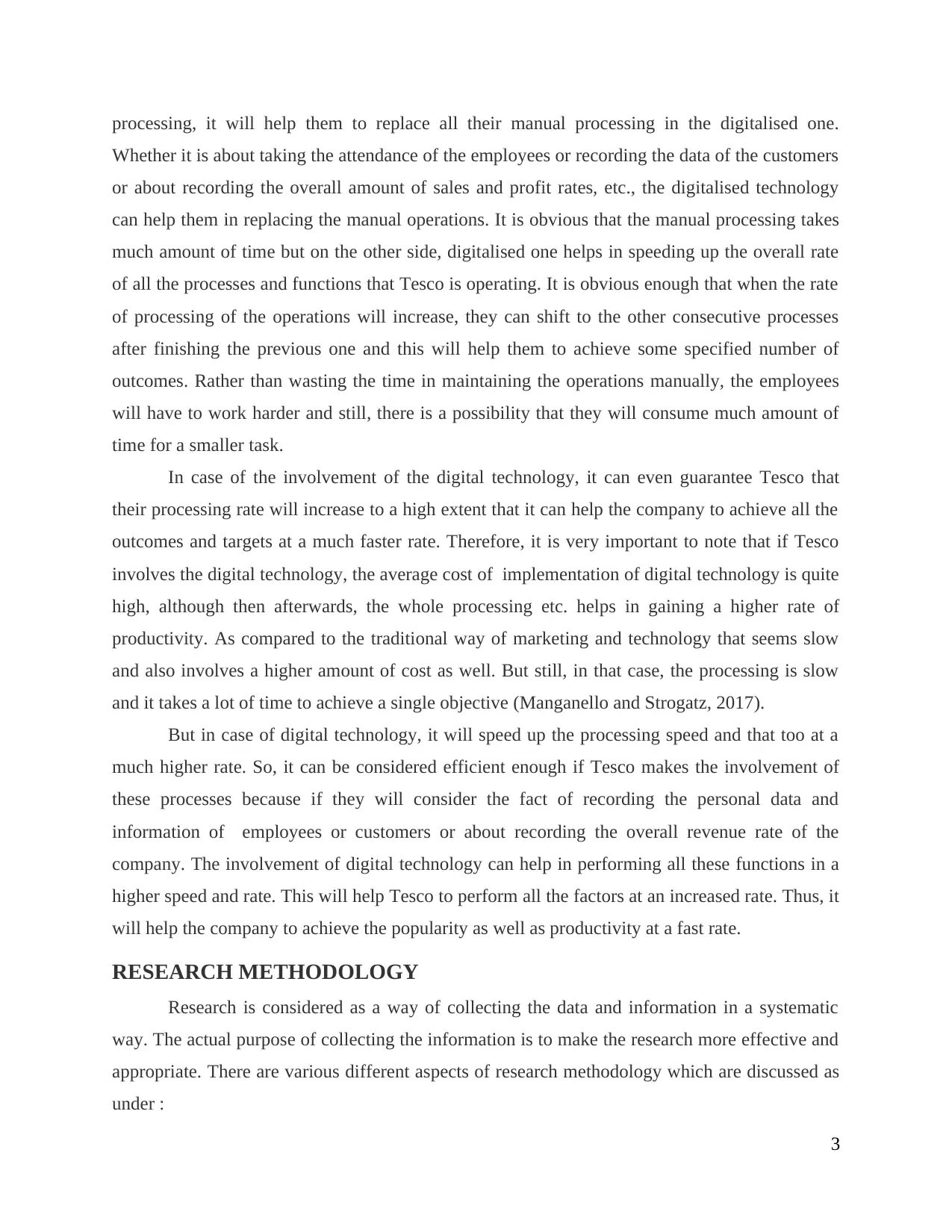
processing, it will help them to replace all their manual processing in the digitalised one.
Whether it is about taking the attendance of the employees or recording the data of the customers
or about recording the overall amount of sales and profit rates, etc., the digitalised technology
can help them in replacing the manual operations. It is obvious that the manual processing takes
much amount of time but on the other side, digitalised one helps in speeding up the overall rate
of all the processes and functions that Tesco is operating. It is obvious enough that when the rate
of processing of the operations will increase, they can shift to the other consecutive processes
after finishing the previous one and this will help them to achieve some specified number of
outcomes. Rather than wasting the time in maintaining the operations manually, the employees
will have to work harder and still, there is a possibility that they will consume much amount of
time for a smaller task.
In case of the involvement of the digital technology, it can even guarantee Tesco that
their processing rate will increase to a high extent that it can help the company to achieve all the
outcomes and targets at a much faster rate. Therefore, it is very important to note that if Tesco
involves the digital technology, the average cost of implementation of digital technology is quite
high, although then afterwards, the whole processing etc. helps in gaining a higher rate of
productivity. As compared to the traditional way of marketing and technology that seems slow
and also involves a higher amount of cost as well. But still, in that case, the processing is slow
and it takes a lot of time to achieve a single objective (Manganello and Strogatz, 2017).
But in case of digital technology, it will speed up the processing speed and that too at a
much higher rate. So, it can be considered efficient enough if Tesco makes the involvement of
these processes because if they will consider the fact of recording the personal data and
information of employees or customers or about recording the overall revenue rate of the
company. The involvement of digital technology can help in performing all these functions in a
higher speed and rate. This will help Tesco to perform all the factors at an increased rate. Thus, it
will help the company to achieve the popularity as well as productivity at a fast rate.
RESEARCH METHODOLOGY
Research is considered as a way of collecting the data and information in a systematic
way. The actual purpose of collecting the information is to make the research more effective and
appropriate. There are various different aspects of research methodology which are discussed as
under :
3
Whether it is about taking the attendance of the employees or recording the data of the customers
or about recording the overall amount of sales and profit rates, etc., the digitalised technology
can help them in replacing the manual operations. It is obvious that the manual processing takes
much amount of time but on the other side, digitalised one helps in speeding up the overall rate
of all the processes and functions that Tesco is operating. It is obvious enough that when the rate
of processing of the operations will increase, they can shift to the other consecutive processes
after finishing the previous one and this will help them to achieve some specified number of
outcomes. Rather than wasting the time in maintaining the operations manually, the employees
will have to work harder and still, there is a possibility that they will consume much amount of
time for a smaller task.
In case of the involvement of the digital technology, it can even guarantee Tesco that
their processing rate will increase to a high extent that it can help the company to achieve all the
outcomes and targets at a much faster rate. Therefore, it is very important to note that if Tesco
involves the digital technology, the average cost of implementation of digital technology is quite
high, although then afterwards, the whole processing etc. helps in gaining a higher rate of
productivity. As compared to the traditional way of marketing and technology that seems slow
and also involves a higher amount of cost as well. But still, in that case, the processing is slow
and it takes a lot of time to achieve a single objective (Manganello and Strogatz, 2017).
But in case of digital technology, it will speed up the processing speed and that too at a
much higher rate. So, it can be considered efficient enough if Tesco makes the involvement of
these processes because if they will consider the fact of recording the personal data and
information of employees or customers or about recording the overall revenue rate of the
company. The involvement of digital technology can help in performing all these functions in a
higher speed and rate. This will help Tesco to perform all the factors at an increased rate. Thus, it
will help the company to achieve the popularity as well as productivity at a fast rate.
RESEARCH METHODOLOGY
Research is considered as a way of collecting the data and information in a systematic
way. The actual purpose of collecting the information is to make the research more effective and
appropriate. There are various different aspects of research methodology which are discussed as
under :
3
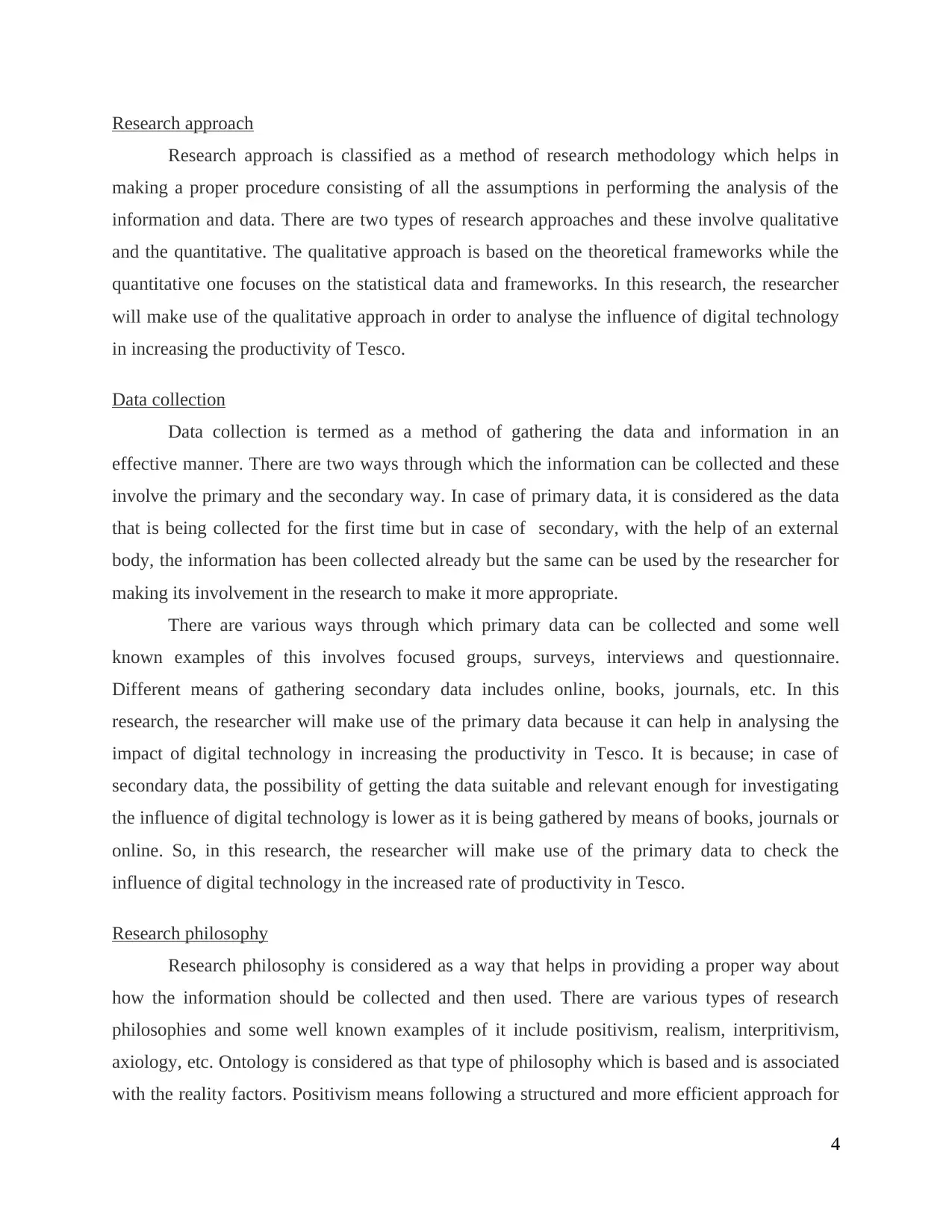
Research approach
Research approach is classified as a method of research methodology which helps in
making a proper procedure consisting of all the assumptions in performing the analysis of the
information and data. There are two types of research approaches and these involve qualitative
and the quantitative. The qualitative approach is based on the theoretical frameworks while the
quantitative one focuses on the statistical data and frameworks. In this research, the researcher
will make use of the qualitative approach in order to analyse the influence of digital technology
in increasing the productivity of Tesco.
Data collection
Data collection is termed as a method of gathering the data and information in an
effective manner. There are two ways through which the information can be collected and these
involve the primary and the secondary way. In case of primary data, it is considered as the data
that is being collected for the first time but in case of secondary, with the help of an external
body, the information has been collected already but the same can be used by the researcher for
making its involvement in the research to make it more appropriate.
There are various ways through which primary data can be collected and some well
known examples of this involves focused groups, surveys, interviews and questionnaire.
Different means of gathering secondary data includes online, books, journals, etc. In this
research, the researcher will make use of the primary data because it can help in analysing the
impact of digital technology in increasing the productivity in Tesco. It is because; in case of
secondary data, the possibility of getting the data suitable and relevant enough for investigating
the influence of digital technology is lower as it is being gathered by means of books, journals or
online. So, in this research, the researcher will make use of the primary data to check the
influence of digital technology in the increased rate of productivity in Tesco.
Research philosophy
Research philosophy is considered as a way that helps in providing a proper way about
how the information should be collected and then used. There are various types of research
philosophies and some well known examples of it include positivism, realism, interpritivism,
axiology, etc. Ontology is considered as that type of philosophy which is based and is associated
with the reality factors. Positivism means following a structured and more efficient approach for
4
Research approach is classified as a method of research methodology which helps in
making a proper procedure consisting of all the assumptions in performing the analysis of the
information and data. There are two types of research approaches and these involve qualitative
and the quantitative. The qualitative approach is based on the theoretical frameworks while the
quantitative one focuses on the statistical data and frameworks. In this research, the researcher
will make use of the qualitative approach in order to analyse the influence of digital technology
in increasing the productivity of Tesco.
Data collection
Data collection is termed as a method of gathering the data and information in an
effective manner. There are two ways through which the information can be collected and these
involve the primary and the secondary way. In case of primary data, it is considered as the data
that is being collected for the first time but in case of secondary, with the help of an external
body, the information has been collected already but the same can be used by the researcher for
making its involvement in the research to make it more appropriate.
There are various ways through which primary data can be collected and some well
known examples of this involves focused groups, surveys, interviews and questionnaire.
Different means of gathering secondary data includes online, books, journals, etc. In this
research, the researcher will make use of the primary data because it can help in analysing the
impact of digital technology in increasing the productivity in Tesco. It is because; in case of
secondary data, the possibility of getting the data suitable and relevant enough for investigating
the influence of digital technology is lower as it is being gathered by means of books, journals or
online. So, in this research, the researcher will make use of the primary data to check the
influence of digital technology in the increased rate of productivity in Tesco.
Research philosophy
Research philosophy is considered as a way that helps in providing a proper way about
how the information should be collected and then used. There are various types of research
philosophies and some well known examples of it include positivism, realism, interpritivism,
axiology, etc. Ontology is considered as that type of philosophy which is based and is associated
with the reality factors. Positivism means following a structured and more efficient approach for
4
⊘ This is a preview!⊘
Do you want full access?
Subscribe today to unlock all pages.

Trusted by 1+ million students worldwide
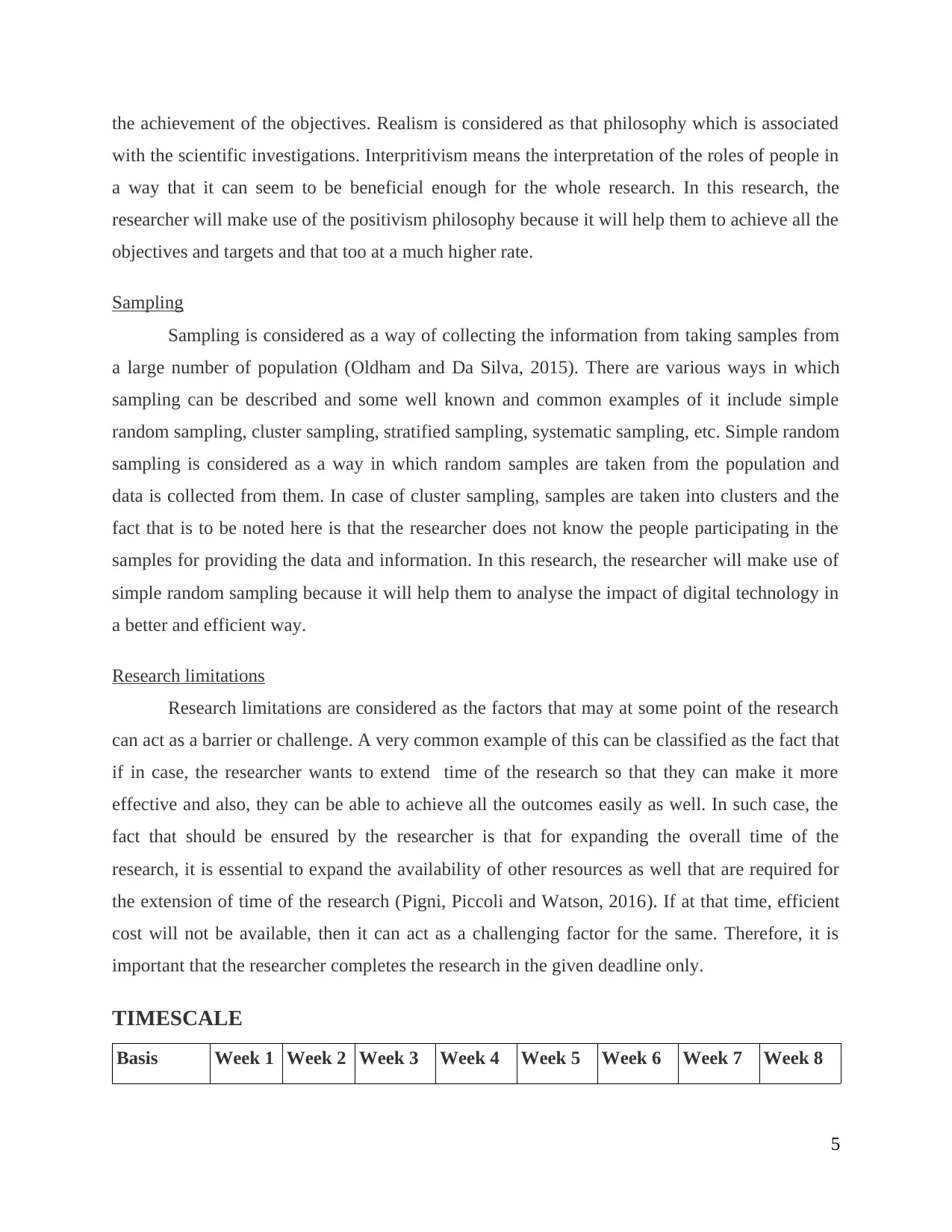
the achievement of the objectives. Realism is considered as that philosophy which is associated
with the scientific investigations. Interpritivism means the interpretation of the roles of people in
a way that it can seem to be beneficial enough for the whole research. In this research, the
researcher will make use of the positivism philosophy because it will help them to achieve all the
objectives and targets and that too at a much higher rate.
Sampling
Sampling is considered as a way of collecting the information from taking samples from
a large number of population (Oldham and Da Silva, 2015). There are various ways in which
sampling can be described and some well known and common examples of it include simple
random sampling, cluster sampling, stratified sampling, systematic sampling, etc. Simple random
sampling is considered as a way in which random samples are taken from the population and
data is collected from them. In case of cluster sampling, samples are taken into clusters and the
fact that is to be noted here is that the researcher does not know the people participating in the
samples for providing the data and information. In this research, the researcher will make use of
simple random sampling because it will help them to analyse the impact of digital technology in
a better and efficient way.
Research limitations
Research limitations are considered as the factors that may at some point of the research
can act as a barrier or challenge. A very common example of this can be classified as the fact that
if in case, the researcher wants to extend time of the research so that they can make it more
effective and also, they can be able to achieve all the outcomes easily as well. In such case, the
fact that should be ensured by the researcher is that for expanding the overall time of the
research, it is essential to expand the availability of other resources as well that are required for
the extension of time of the research (Pigni, Piccoli and Watson, 2016). If at that time, efficient
cost will not be available, then it can act as a challenging factor for the same. Therefore, it is
important that the researcher completes the research in the given deadline only.
TIMESCALE
Basis Week 1 Week 2 Week 3 Week 4 Week 5 Week 6 Week 7 Week 8
5
with the scientific investigations. Interpritivism means the interpretation of the roles of people in
a way that it can seem to be beneficial enough for the whole research. In this research, the
researcher will make use of the positivism philosophy because it will help them to achieve all the
objectives and targets and that too at a much higher rate.
Sampling
Sampling is considered as a way of collecting the information from taking samples from
a large number of population (Oldham and Da Silva, 2015). There are various ways in which
sampling can be described and some well known and common examples of it include simple
random sampling, cluster sampling, stratified sampling, systematic sampling, etc. Simple random
sampling is considered as a way in which random samples are taken from the population and
data is collected from them. In case of cluster sampling, samples are taken into clusters and the
fact that is to be noted here is that the researcher does not know the people participating in the
samples for providing the data and information. In this research, the researcher will make use of
simple random sampling because it will help them to analyse the impact of digital technology in
a better and efficient way.
Research limitations
Research limitations are considered as the factors that may at some point of the research
can act as a barrier or challenge. A very common example of this can be classified as the fact that
if in case, the researcher wants to extend time of the research so that they can make it more
effective and also, they can be able to achieve all the outcomes easily as well. In such case, the
fact that should be ensured by the researcher is that for expanding the overall time of the
research, it is essential to expand the availability of other resources as well that are required for
the extension of time of the research (Pigni, Piccoli and Watson, 2016). If at that time, efficient
cost will not be available, then it can act as a challenging factor for the same. Therefore, it is
important that the researcher completes the research in the given deadline only.
TIMESCALE
Basis Week 1 Week 2 Week 3 Week 4 Week 5 Week 6 Week 7 Week 8
5
Paraphrase This Document
Need a fresh take? Get an instant paraphrase of this document with our AI Paraphraser
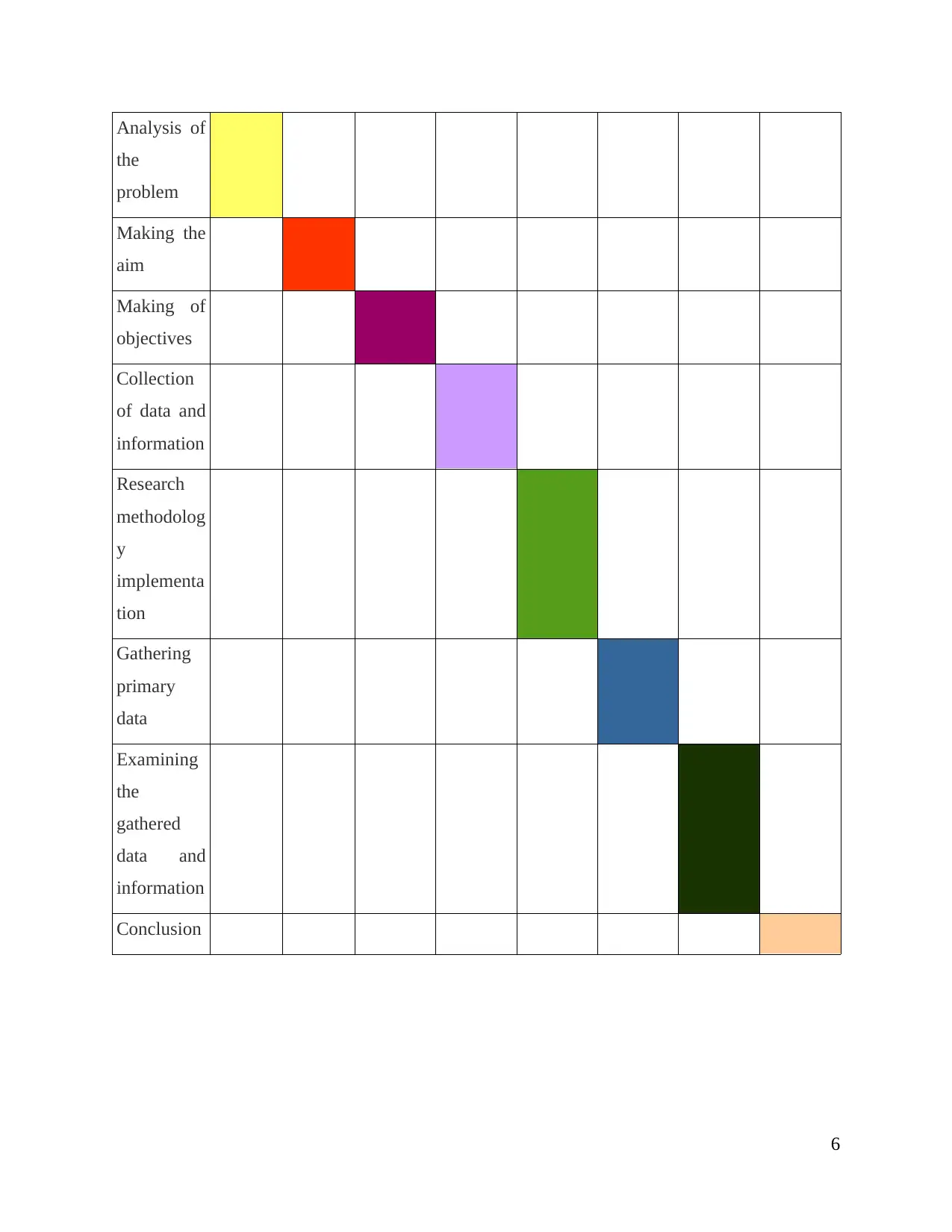
Analysis of
the
problem
Making the
aim
Making of
objectives
Collection
of data and
information
Research
methodolog
y
implementa
tion
Gathering
primary
data
Examining
the
gathered
data and
information
Conclusion
6
the
problem
Making the
aim
Making of
objectives
Collection
of data and
information
Research
methodolog
y
implementa
tion
Gathering
primary
data
Examining
the
gathered
data and
information
Conclusion
6
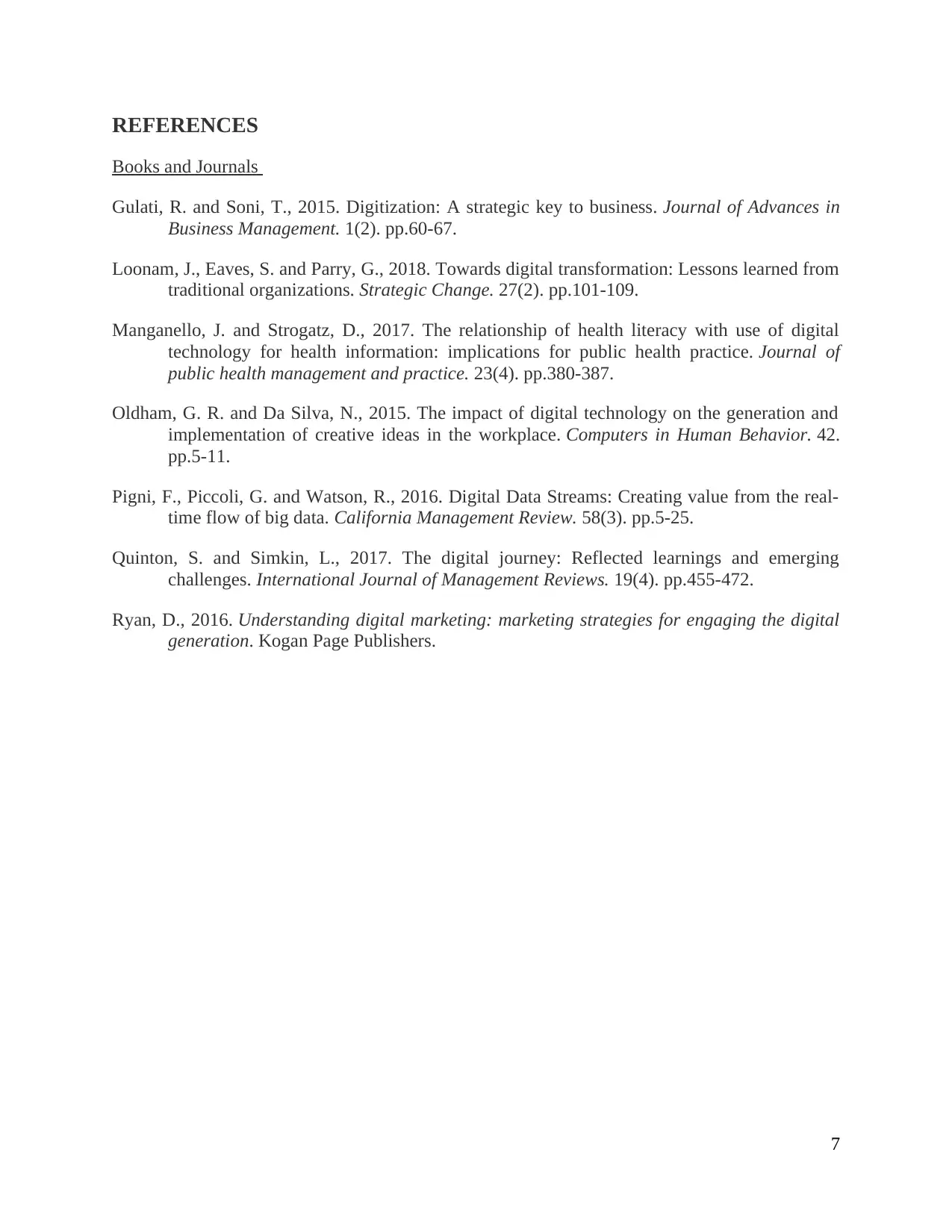
REFERENCES
Books and Journals
Gulati, R. and Soni, T., 2015. Digitization: A strategic key to business. Journal of Advances in
Business Management. 1(2). pp.60-67.
Loonam, J., Eaves, S. and Parry, G., 2018. Towards digital transformation: Lessons learned from
traditional organizations. Strategic Change. 27(2). pp.101-109.
Manganello, J. and Strogatz, D., 2017. The relationship of health literacy with use of digital
technology for health information: implications for public health practice. Journal of
public health management and practice. 23(4). pp.380-387.
Oldham, G. R. and Da Silva, N., 2015. The impact of digital technology on the generation and
implementation of creative ideas in the workplace. Computers in Human Behavior. 42.
pp.5-11.
Pigni, F., Piccoli, G. and Watson, R., 2016. Digital Data Streams: Creating value from the real-
time flow of big data. California Management Review. 58(3). pp.5-25.
Quinton, S. and Simkin, L., 2017. The digital journey: Reflected learnings and emerging
challenges. International Journal of Management Reviews. 19(4). pp.455-472.
Ryan, D., 2016. Understanding digital marketing: marketing strategies for engaging the digital
generation. Kogan Page Publishers.
7
Books and Journals
Gulati, R. and Soni, T., 2015. Digitization: A strategic key to business. Journal of Advances in
Business Management. 1(2). pp.60-67.
Loonam, J., Eaves, S. and Parry, G., 2018. Towards digital transformation: Lessons learned from
traditional organizations. Strategic Change. 27(2). pp.101-109.
Manganello, J. and Strogatz, D., 2017. The relationship of health literacy with use of digital
technology for health information: implications for public health practice. Journal of
public health management and practice. 23(4). pp.380-387.
Oldham, G. R. and Da Silva, N., 2015. The impact of digital technology on the generation and
implementation of creative ideas in the workplace. Computers in Human Behavior. 42.
pp.5-11.
Pigni, F., Piccoli, G. and Watson, R., 2016. Digital Data Streams: Creating value from the real-
time flow of big data. California Management Review. 58(3). pp.5-25.
Quinton, S. and Simkin, L., 2017. The digital journey: Reflected learnings and emerging
challenges. International Journal of Management Reviews. 19(4). pp.455-472.
Ryan, D., 2016. Understanding digital marketing: marketing strategies for engaging the digital
generation. Kogan Page Publishers.
7
⊘ This is a preview!⊘
Do you want full access?
Subscribe today to unlock all pages.

Trusted by 1+ million students worldwide
1 out of 9
Related Documents
Your All-in-One AI-Powered Toolkit for Academic Success.
+13062052269
info@desklib.com
Available 24*7 on WhatsApp / Email
![[object Object]](/_next/static/media/star-bottom.7253800d.svg)
Unlock your academic potential
Copyright © 2020–2025 A2Z Services. All Rights Reserved. Developed and managed by ZUCOL.





